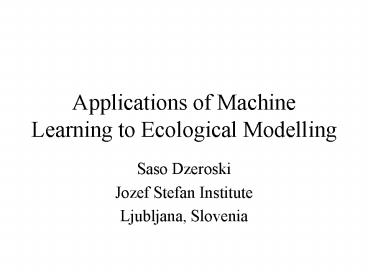Applications of Machine Learning to Ecological Modelling PowerPoint PPT Presentation
Title: Applications of Machine Learning to Ecological Modelling
1
Applications of Machine Learning to Ecological
Modelling
- Saso Dzeroski
- Jozef Stefan Institute
- Ljubljana, Slovenia
2
Ecological modelling and machine learning
- The goals of modelling include
- understanding the domain studied
- predicting future values of system variables of
interest - decision support for environmental management
- Machine learning can be used to
- automate modelling
- discover knowledge that meets some or all of the
above goals
3
Analysis of water quality data
- Biological classification
- British rivers
- Slovenian rivers
- Predicting chemical parameters of water quality
from bioindicator data - British rivers
- Slovenian rivers
- Determining ecological requirements
of some organisms in Slovenian rivers
4
Modelling
- Modelling algal growth
- Lagoon of Venice
- Lake of Bled
- Modelling phytoplankton growth
- Modelling a red deer population
5
Environmental applications of machine learning
- Analysis of the influence of environmental
factors on respiratory diseases - Analysis of the influence of soil habitat
features on the abundance of Collembola - Predicting biodegradability of chemical
compounds - Runoff prediction from rainfall and past runoff
6
A regression tree for predicting algal growth in
the Venice lagoon
7
Rules for classifying British Midland rivers into
quality classes based on the community of
benthic macroinvertebrates
- IF Hydrobiidae lt 3
- AND Planorbidae lt 0
- AND Gammaridae lt 5
- AND Leuctridae gt 0
- THEN Class B1a 42 0 0 0 0
- IF Asellidae gt 2
- AND 0 lt Gammaridae lt 4
- AND Scirtidae lt 0
- THEN Class B2 0 0 41 0 0
IF Planariidae lt 0 AND Tubificidae gt 0
AND Lumbricidae lt 0 AND Glossiphoniidae lt 2
AND Asellidae gt 0 AND Gammaridae lt 0 AND
Veliidae lt 0 AND Hydropsychidae lt 0 AND
Simulidae lt 0 AND Muscidae lt 0 THEN Class B3
0 0 3 28 10
8
Rate of change equation for phytoplankton growth
in Lake Glumsoe, Denmark
- Variables in the model are the concentrations of
- phytoplankton phyt
- zooplankton zoo
- soluble nitrogen nitro
- soluble phosphorus phosp
- water temperature temp
9
Analysis of environmental data with machine
learning methods 22-25 April 2002, Ljubljana
- http//www-ai.ijs.si/SasoDzeroski/aep/
- Introduction to machine learning
- and its environmental applications
- Data mining and knowledge discovery
10
Contents of course
- Induction of decision and regression trees
- Induction of classification rules
- Bayesian classification
- Nearest neighbor classification
- Evaluating, selecting and combining classifiers
- Equation discovery
- Practical hands-on exercises on environmental
datasets - Applications of machine learning to environmental
problems
11
Recent applications
(joint work with participants from previous
seminars)
- Topics considered at workshops
- Modelling a red deer population (data cleaning,
body-weight model for calves of the year,
two year olds and hinds) - Influence of environmental and social factors on
acute respiratory diseases in children - Influence of various parameters on alkalinity of
an artificial lake near an ashes dump - Modelling the transport of concrete through pipes
12
Recent applications
(joint work with participants from previous
seminars)
- Habitat-suitability modelling (using GIS data and
animal locations - sightings/radio-tracking) - red deer (Debeljak et al. 1999)
- brown bears (A. Kobler and M. Adamic 1999) used
to identify locations for wildlife bridges across
highways - Influence on concentrations of dissolved reactive
phosphorus in surface runoff from arable land
(Weissroth and Deroski 1999) - Diagnosis of a waste-water treatment plant
(Deroski and Comas 1999)

